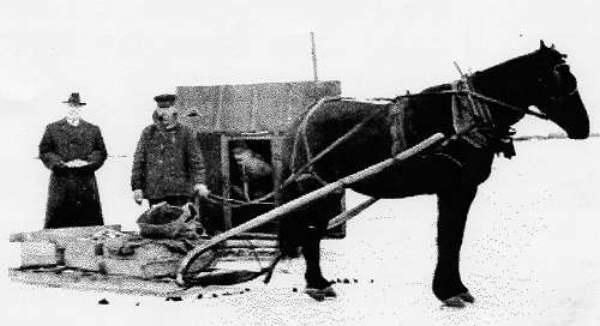| Home | Schools | Economy - Local | The Scene | Local News | History | Dave Rogers |
| Industry | Wine/Beer | Great Lakes | Julie McCallum | Fundraising | KA$H FOR KARAOKE | Outdoors |
| Politics | ||||||
The Ice is Up, Honey: See You in the Spring--Fishing Villages of the 1890s
|
||||||||||||||||
| Printer Friendly Story View |

Several walleye "keepers" were in the buckets of Jason Comer, left, and Craig Haske, as they came off the ice near the USS Edson dock on the Saginaw River.

Photo from 1911 shows William Patenge, of Essexville, (long coat) buying fresh fish at the "Ice City" on Saginaw Bay.
ICE FISHING CAUTION: Ice is accessible on most Michigan waterways but keep safe. Wear a life jacket, and don't go alone or at least have a cell phone. Make sure that the ice is at least 4 or more inches thick.
Fishing on the Saginaw River ice near the USS Edson dock (Independence Park) was reported spotty last week.
Two anglers, Jason Comer, 35, of Saginaw, and Craig Haske, 36, Reese, came off the ice about 11 a.m. Thursday after a few hours of fishing with a few medium size walleye keepers.
"We caught lots of small ones, 11-12 inches, so that indicates fishing will be good in the future as those fish grow," said Comer.
Dozens of anglers were on the ice from the bridge to the Jupiter dock, a few with shanties but many roughing the cold weather.
The Michigan Department of Natural Resources reported: "Ice anglers are fishing shallow waters. Early shelf ice was good for perch but that has slowed. There were reports of fish caught near the Bay City State Park. The Bay still had some open water so anglers need to use caution. Walleye anglers are catching fish near the mouth of the Saginaw River."
Maps posted on the web showed 17 fishing locations on the Saginaw River from Bay City north to the mouth and several on the bay, and the fishermen interviews said there are good spots on the ice in and near Saginaw.
We talked a little about ice fishing over a century ago in this area, Haske recalling hearing stories that years ago near Sebewaing horses would be driven out onto the ice to bring in the catch.
Marv Kusmierz, local historian from bay-journal.com, responded to the season by forwarding an amazing story of ice fishing off Essexville that appeared in a British magazine "Fore's Sporting Notes and Sketches" in 1890.
The article, entitled "City on the Ice" was a first hand report written by one Wilf Pocklinton, who commented the city on the ice of Saginaw Bay "has not its duplicate in the world." He described how local men took desperate risks but reaped huge financial rewards from their winter-long ice fishing adventure.
Pocklinton quotes a local lumberman, Charlie Denman, who had invited the Englishman to spend Christmas and enjoy sport, including duck hunting and fishing.
That times and weather conditions were vastly different then is apparent from Pocklinton's report that ice fishing here in the 1890s started in October and broke up about mid-April. He wrote: "The weather up here is very cold, often falling to 40 below zero for several days at a time, and great snow storms occur that place several feet of snow on the level in a single night."
The writer estimated that the "City on the Ice" of Saginaw Bay was populated by two to five thousand people, mainly men, who stayed the entire season in houses dragged onto the ice.
The houses, described as wooden huts 10 feet long, six feet wide and seven feet high, are drawn by dogs onto the bay.
"Wives, families and sweethearts are all left behind for many months and in some cases forever, the casualties being large every year through the carelessness of the men, and numbers are drowned, frozen, lost in a blizzard, driven out to sea, or devoured by gray wolves which frequent this part of the country in large numbers."
Pocklinton described the inhabitants of the City on the Ice: "The men are brawny and muscular, and during the summer remain at home with their families, and hunt ducks for a living."
The men dress nearly all alike in bright red mackinaw trousers nearly an inch thick, bright blue shirts and have a bright red woolen scarf around their waists, the writer observed.
Calked (spiked) Michigan lumber boots up to the knee are worn along with a broad-brimmed felt hat like that worn by cowboys. "Attired in this picturesque dress, the dweller of the ice city presents a curious sight to a stranger, upon whose thin clothes and voluminous wraps of fur they look with disdain and contempt."
Typical fish shanty style holes in the floor of the houses are placed over holes in the ice, the British writer observed. Tip-ups made from three-legged twigs were used.
"The dogs as a rule are very intelligent, and watch the 'tip-ups' quite as assiduously as their masters, and when a fish is caught they pounce upon the line, and if the door of the hut is open, will run out, drawing the line taut, until the fish is at the surface."
Fish caught were giant perch, silver whitefish, pickerel, pike, sand-pike, giant sun fish, bass, muskellunge, cat-fish, sturgeon, eels and bull-heads. The fish were stored in covered tanks set in the ice.
Twice a week a large flat-bottomed scow, or barge, on runners, drawn by eight horses comes from Bay City, calling at each hut, paying so much per pound for the fish. The catch is shipped to Detroit, Buffalo and the east.
"Private consumers and local dealers fetch their fish from the Ice City as they need it; the fish are plentiful, and bite easily and well, so that good wages are made by the men in this careless lazy way, the money made running from three to ten pounds a week per man, according to his luck and the work he does.
"Wednesday or Thursday are the busiest days at the 'city,' for then the fish scow comes in, and the visitors from the mainland usually take advantage of the auction of fine fish held on that day."
Sudden storms were said to push houses far out toward Charity Islands, then inhabited by the Kohkahlin tribe of Indians who subsisted on hunting and fishing like their ancestors of yore.
"To these islands the fishermen make their way before an expected storm, and it is no uncommon thing to see the whole city moving en masse in that direction."
One paragraph especially describes the attitudes of ice fishermen persisting until the present and will be familiar to today's reader:
"Year after year many of the fishermen are lost, but no experience seems to make them wise. The profit attending the bay fishing is so great, and work so easy, and the good times so many, that instead of clearing away when the first symptoms of ice melting appears, they hang on until the frail ice gives way beneath them or the floe breaks and they are driven helplessly into the great lake before the force of a great storm."
###
| Printer Friendly Story View |

|
Prior Article
March 5, 2025 by: Stephen Kent St. Patricks Parade 2025 - IT's TIME |

|
Next Article
March 5, 2025 by: Stephen Kent St. Patricks Parade 2025 - IT's TIME |
"The BUZZ" - Read Feedback From Readers! |
|
TommyA says:
On January 13, 2010
at 09:56 AM
Great story Dave. I'll never look at the ice, or the ice fishermen on the Saginaw River in quite the same way again.
|
|
|

Dave Rogers |
|
|
|
Printer-Friendly Story View
0200 Nd: 12-28-2025 d 4 cpr 1
12/31/2020 P3v3-0200-Ad.cfm
SPONSORED LINKS
12/31/2020 drop ads P3v3-0200-Ad.cfm
